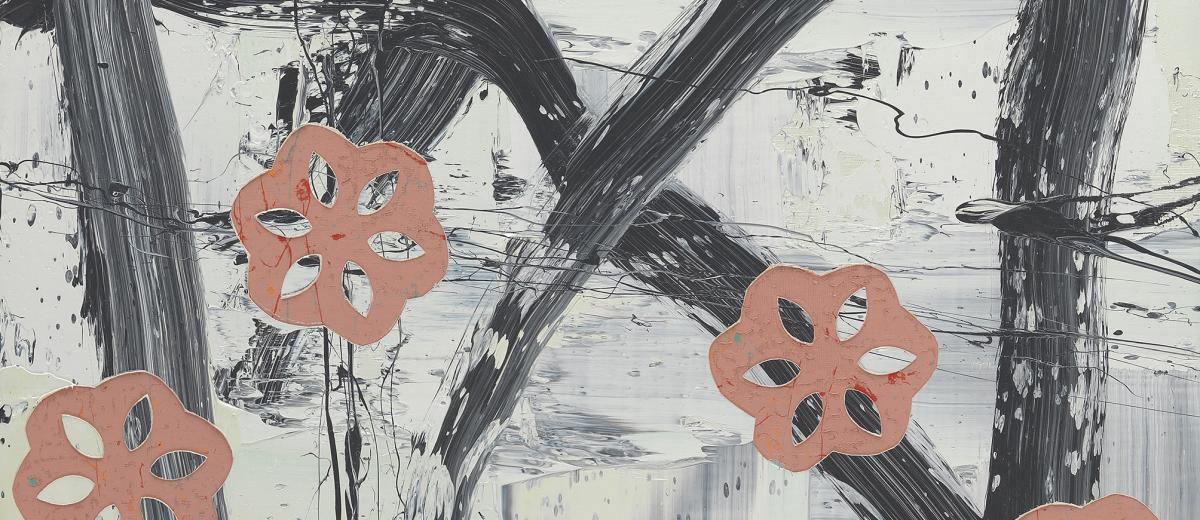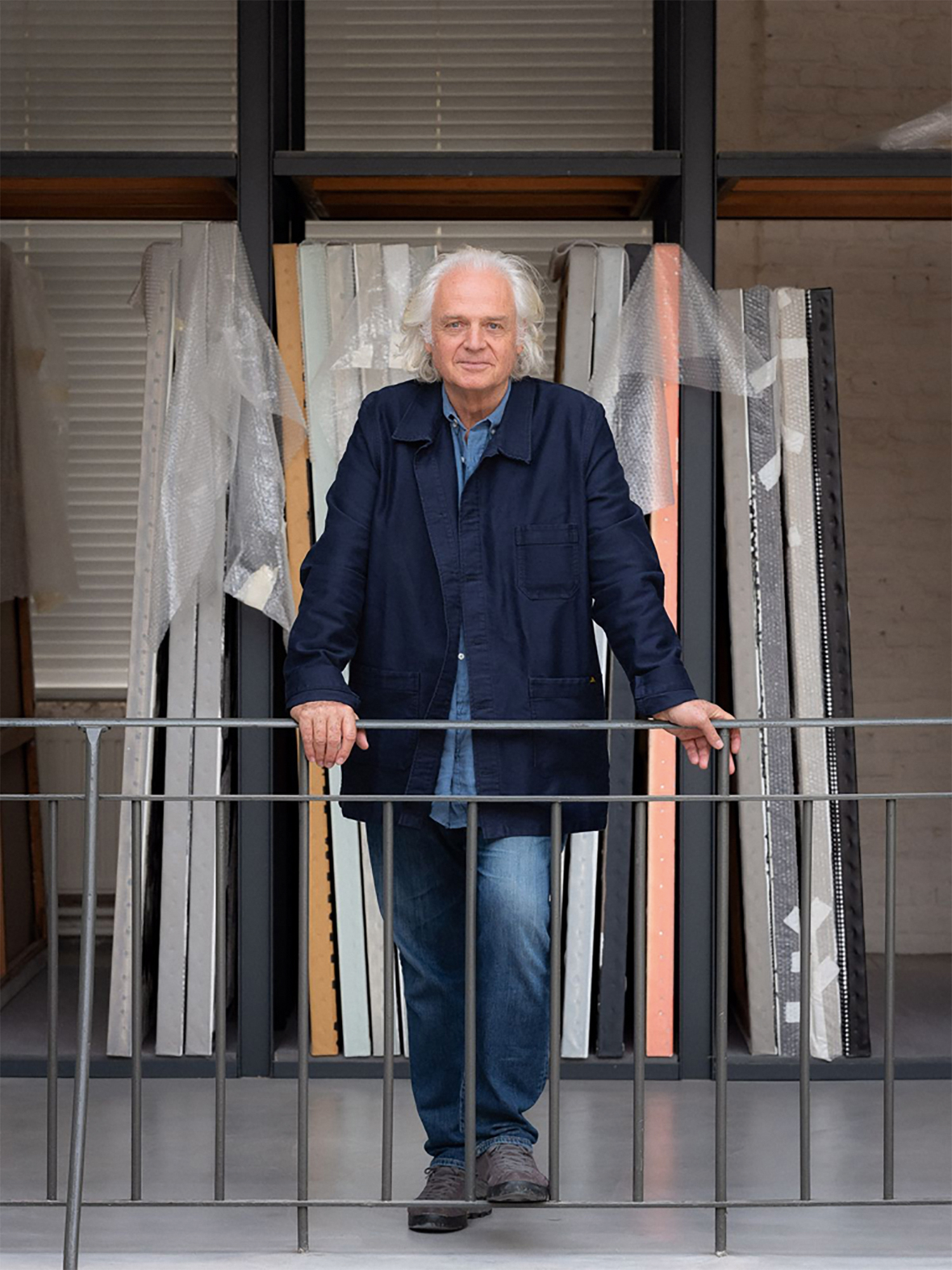H. Yves Zurstrassen

Yves Zurstrassen’s art is in constant evolution but one factor remains unchangeable: his desire for free, intuitive expression. A dynamic series of abstract shapes and colours, including orange, bright yellow and blue, characterise his recent canvases. His painting draws inspiration from the soundscapes of jazz and abstract art, always prioritising invention and playfulness. Zurstrassen conceives his paintings step by step, scene by scene, combining different techniques and revisiting the artistic practices that marked the history of abstract painting in the 20th century, always with the aim of deconstructing them. Jazz and free jazz also play a major role in his body of work, which is strongly influenced by such great musicians as John Coltrane, Ornette Coleman, Eric Dolphy, Joëlle Léandre and Evan Parker, with whom the artist “communicates through painting”.
Guiding the painter’s thought and hand, creative, improvisational freedom leads him to bank on the principles of change, surprise, and opposing views, which continuously infuse the space he creates with intensity. A space that the painter wants to inhabit and share with us as a perceptive mental experience. Each of his paintings is a pictorial territory constructed by a suite of intuitions, contrasts and impulses as principles or methodical organisation “I’m self-taught,” Yves Zurstrassen points out. “I’m not an intellectual who plans what I paint, it’s the painting that guides me, which teaches me what I know, what I am. Which enables me to attain a form of knowledge.”
What is particularly striking about his work is the repetition of motifs and details from one painting to the next. What might covertly and radically transform the subject of a future painting may elsewhere become the painting in its entirety. Yves Zurstrassen works tirelessly on this approach to multiple variations of depth. In 1999, he started composing using components cut from earlier works or from newspapers. Collages, which would soon come to be detached from the surface of the canvas, so removing the paint and letting the reserve appear, or the impression of the paint with which the fragment of collage had been coated.
The artist plays with fragments, sticking and unsticking them, all the more easily when digitisation lends a hand. In 2005, he adopted this technology in order to act upon images, quotations borrowed from pictures in the urban space and daily life, before making use of them in his “collages-décollages”. The same year, he installed a digital plotter in his studio, enabling him to create paper stencils. Initially, these motifs were placed on the composition but later on served as backgrounds. All this became clear on the occasion of Yves Zurstrassen-Free exhibition at BOZAR Centre for Fine Arts (Brussels) in 2019-2020.
As the exhibition’s curator Olivier Kaeppelin also explained, “The works follow the same roads that Yves Zurstrassen travels in order to appropriate them, in order to interpret them, ‘undo’ them if you like…to forget them and compose his own score, his mental attitude, which is to prepare for the emergence of a surprise. He states it clearly enough: “I need to disrupt the system that I myself built. I need this rhythm: affirmation, repetition, and rupture. Calling into question the systems I’ve developed rewards me, recharges me, enables me to exist”. I see the vitalist principle at play in his work here. He connects with neurobiology and neurogenetics, which see the experience of surprise as one of our neuronal activity’s most essential processes, warding off cerebral anaemia. I sense that this is the source of the joy that radiates from his work, preventing him from copying himself.”
BIOGRAPHICAL NOTES

Yves Zurstrassen was born in Liège in 1956. He spent his childhood in the Vesdre Valley, between the Ardennes and Hautes Fagnes. When he was ten years old, the decline in the wool industry forced his family to leave Verviers and move to Brussels. As a teenager, he knew that his future lay in painting. From the age of 18, he alternated studio work with long periods in France, at the Chartreuse de La Verne or in Andalusia, where he painted outdoors. These stays had a decisive influence on his work.
A self-taught painter who had trained in the graphic arts, he learned his trade in the 1980s, visiting artists’ studios and retrospectives of the masters he felt affinities with, such as Fernand Léger, Stuart Davis, Willem De Kooning and Mark Tobey. Zurstrassen, who stood his ground against the notion that abstract painting was dead, deliberately chose to make it his own. With nothing more than a stretcher frame, canvas, paper and paint, he set off in search of a new freedom of expression. In this respect, he could be compared with Jonathan Lasker, Albert Oehlen, Christian Bonnefoi or Juan Uslé. He also decided never to make colour dependent on figure, and exhibited for the first time in Brussels in 1982.
Yves Zurstrassen has developed a creative process all his own, making use of the technique of collage and décollage of various paper shapes on successive layers of colour. In the late 1990s, he moved into a disused industrial building, which he adapted to his work and research. The 2000s saw a change in his approach, inspired by his fascination for the Dada movement Dada, Kurt Schwitters’ collages most of all. He started out with small-format studies, which became larger as he went on, fine-tuning his technique by adding collages composed of torn or cut-up newspaper, which he incorporates into the painting and then detaches from it, removing some of the paint by doing so. It’s what he refers to as opening the windows in the painting’s memory. These collages also include fragments of photographs, which he finds in the public space and reworks digitally. In the early 2010s, his cutout motifs changed places, serving to cover the entire background.
Zurstrassen’s body of work has helped bring about a renewal in abstraction, and may be compared with the works of such American artists as Philips Taaffe, Jonathan Lasker, Albert Oehlen, Ernst Caramelle and Peter Halley, and such Europeans as Noël Dolla, Juan Uslé, José Manuel Broto, Rockenschaub and Bernard Frize. He has held solo exhibitions at such venues as the Holstebro Museum (Denmark), the IKOB Museum in Eupen (Belgium), Aboa Vetus & Ars Nova in Turku (Finland), MAMAC in Liège (Belgium), the Antonio Paz Foundation in Cuenca (Spain) and the Santa Cruz Museum in Toledo. Yves Zurstrassen’s works have formed the subject of numerous critical texts, including essays by Wolfgang Becker, François Barré, Xavier Douroux, Olivier Kaeppelin, Renate Puvogel and Anne Pontegnie.